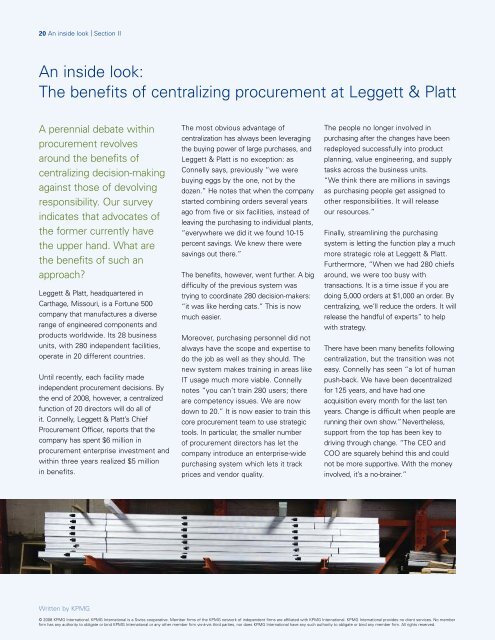Beyond purchasing
Create successful ePaper yourself
Turn your PDF publications into a flip-book with our unique Google optimized e-Paper software.
20 An inside look | Section II<br />
An inside look:<br />
The benefits of centralizing procurement at Leggett & Platt<br />
A perennial debate within<br />
procurement revolves<br />
around the benefits of<br />
centralizing decisionmaking<br />
against those of devolving<br />
responsibility. Our survey<br />
indicates that advocates of<br />
the former currently have<br />
the upper hand. What are<br />
the benefits of such an<br />
approach?<br />
Leggett & Platt, headquartered in<br />
Carthage, Missouri, is a Fortune 500<br />
company that manufactures a diverse<br />
range of engineered components and<br />
products worldwide. Its 28 business<br />
units, with 280 independent facilities,<br />
operate in 20 different countries.<br />
Until recently, each facility made<br />
independent procurement decisions. By<br />
the end of 2008, however, a centralized<br />
function of 20 directors will do all of<br />
it. Connelly, Leggett & Platt’s Chief<br />
Procurement Officer, reports that the<br />
company has spent $6 million in<br />
procurement enterprise investment and<br />
within three years realized $5 million<br />
in benefits.<br />
The most obvious advantage of<br />
centralization has always been leveraging<br />
the buying power of large purchases, and<br />
Leggett & Platt is no exception: as<br />
Connelly says, previously “we were<br />
buying eggs by the one, not by the<br />
dozen.” He notes that when the company<br />
started combining orders several years<br />
ago from five or six facilities, instead of<br />
leaving the <strong>purchasing</strong> to individual plants,<br />
“everywhere we did it we found 1015<br />
percent savings. We knew there were<br />
savings out there.”<br />
The benefits, however, went further. A big<br />
difficulty of the previous system was<br />
trying to coordinate 280 decisionmakers:<br />
“it was like herding cats.” This is now<br />
much easier.<br />
Moreover, <strong>purchasing</strong> personnel did not<br />
always have the scope and expertise to<br />
do the job as well as they should. The<br />
new system makes training in areas like<br />
IT usage much more viable. Connelly<br />
notes “you can’t train 280 users; there<br />
are competency issues. We are now<br />
down to 20.” It is now easier to train this<br />
core procurement team to use strategic<br />
tools. In particular, the smaller number<br />
of procurement directors has let the<br />
company introduce an enterprisewide<br />
<strong>purchasing</strong> system which lets it track<br />
prices and vendor quality.<br />
The people no longer involved in<br />
<strong>purchasing</strong> after the changes have been<br />
redeployed successfully into product<br />
planning, value engineering, and supply<br />
tasks across the business units.<br />
“We think there are millions in savings<br />
as <strong>purchasing</strong> people get assigned to<br />
other responsibilities. It will release<br />
our resources.”<br />
Finally, streamlining the <strong>purchasing</strong><br />
system is letting the function play a much<br />
more strategic role at Leggett & Platt.<br />
Furthermore, “When we had 280 chiefs<br />
around, we were too busy with<br />
transactions. It is a time issue if you are<br />
doing 5,000 orders at $1,000 an order. By<br />
centralizing, we’ll reduce the orders. It will<br />
release the handful of experts” to help<br />
with strategy.<br />
There have been many benefits following<br />
centralization, but the transition was not<br />
easy. Connelly has seen “a lot of human<br />
pushback. We have been decentralized<br />
for 125 years, and have had one<br />
acquisition every month for the last ten<br />
years. Change is difficult when people are<br />
running their own show.”Nevertheless,<br />
support from the top has been key to<br />
driving through change. “The CEO and<br />
COO are squarely behind this and could<br />
not be more supportive. With the money<br />
involved, it’s a nobrainer.”<br />
© 2008 KPMG International. KPMG International is a Swiss cooperative. Member firms of the KPMG network of independent firms are affiliated with KPMG International. KPMG International provides no client services. No member<br />
firm has any authority to obligate or bind KPMG International or any other member firm visàvis third parties, nor does KPMG International have any such authority to obligate or bind any member firm. All rights reserved.



